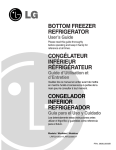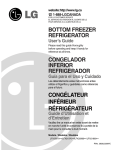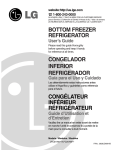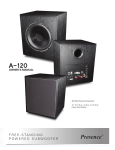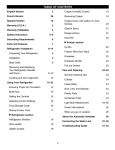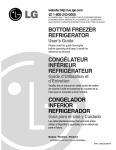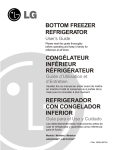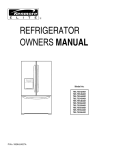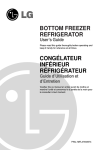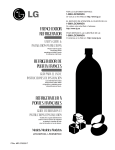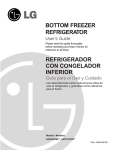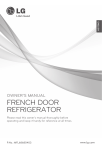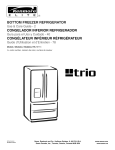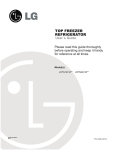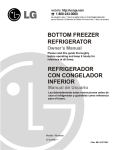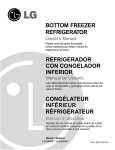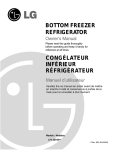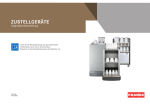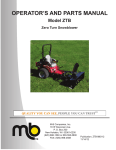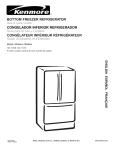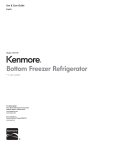Download LG LFX25950 User's Manual
Transcript
website http://us.lge.com
☎ 1-800-243-0000
24 HOURS A DAY, 7 DAYS A WEEK FOR LG CUSTOMER SERVICE
para el Servicio LG (Atención al Cliente) 24 horas al día, 7 días a la semana
24 HEURES SUR 24, SERVICE À LA CLIENTÈLE LG 7 JOURS SUR 7
BOTTOM FREEZER
REFRIGERATOR
User’s Guide
Please read this guide thoroughly
before operating and keep it handy for
reference at all times.
CONGELADOR
INFERIOR
REFRIGERADOR
Guía para el Uso y Cuidado
Lea detenidamente estas instrucciones antes
utilizar el frigorífico y guárdelas como referencia
para el futuro.
CONGÉLATEUR
INFÉRIEUR
RÉFRIGÉRATEUR
Guide d’Utilisation et
d’Entretien
Veuillez lire ce manuel en entier avant de mettre
en marche l'unité et conservez-le à portée de la
main pour le consulter à tout moment.
Models / Modelos / Modèles
LFX25950**
P/No. MFL37933501
TABLE OF CONTENTS
English Version
2
Spanish Version
40
u Freezer Section
French Version
78
Ice Bin
26
Warranty (USA)
3
Durabase
27
Warranty (CANADA)
4
Durabase Divider
27
Pull Out Drawer
27
Filter
28
Safety Instructions
Grounding Requirements
Parts And Features
Refrigerator Installation
Modular Door Bin
5–10
6
11
Care And Cleaning
12–19
26
29–30
General Cleaning Tips
29
Unpacking Your Refrigerator
12
Outside
29
Installation
12
Inside Walls
29
Door Liner And Gaskets
29
Plastic Parts
29
Removing And Replacing
Your Refrigerator Handles
And Doors
13–18
Leveling And Door Alignment
19
Base Cover
19
Using Your Refrigerator
Light Bulb Replacement
20–28
Setting The Controls
20
Ensuring Proper Air Circulation
21
How To Use A New Door Ice Bucket
22
Adjusting Control Settings
23
Food Storage Guide
23
Storing Frozen Food
24
Water Dispenser
24
Refrigerator Shelves
25
Snack Pan
25
Crisper Humidity Control
25
Removing Crisper
26
Dairy Bin
26
Power Interruptions
30
When You Go On Vacation
30
When You Move
30
About The Automatic Icemaker
u Refrigerator Section
2
29–30
31
Connecting The Water Line
32–34
Troubleshooting Guide
35–38
LG ELECTRONICS, INC.
LG REFRIGERATOR LIMITED WARRANTY - USA
Your LG Refrigerator will be will repaired or replaced, at LG’s option, if it proves to be defective in material or
workmanship under normal use, during the warranty period ("Warranty Period") set forth below, effective from the date
("Date of Purchase") of original consumer purchase of the product. This warranty is good only to the original purchaser
of the product and effective only when used in the United States, including Alaska, Hawaii, and U.S. Territories.
HOW SERVICE IS HANDLED
In-Home Service (Except Model GR051)
Please retain dealer’s dated bill of sale or delivery
ticket as evidence of the Date of Purchase for proof of
warranty, and submit a copy of the bill of sale to the
service person at the time warranty service is
provided.
Please call 1-800-243-0000 and choose the
appropriate option to locate your nearest LG
Authorized Service Center. (Phones are answered
24 hours a day, 365 days per year.)
WARRANTY PERIOD
REFRIGERATOR/FREEZER
LABOR: One Year from the Date of Purchase.
PARTS: One Year from the Date of Purchase.
SEALED SYSTEM (Compressor, Condenser, and
Evaporator)
LABOR: One Year from the Date of Purchase.
PARTS: Seven years from the Date of Purchase.
Replacement Units and Repair Parts are warranted
for the remaining portion of the original unit’s warranty
period.
Or visit our website at http://www.lgservice.com
THIS WARRANTY IS IN LIEU OF ANY OTHER WARRANTY, EXPRESS OR IMPLIED, INCLUDING WITHOUT
LIMITATION, ANY WARRANTY OF MERCHANTABILITY OR FITNESS FOR A PARTICULAR PURPOSE. TO THE
EXTENT ANY IMPLIED WARRANTY IS REQUIRED BY LAW, IT IS LIMITED IN DURATION TO THE EXPRESS
WARRANTY PERIOD ABOVE. NEITHER THE MANUFACTURER NOR ITS U.S. DISTRIBUTOR SHALL BE LIABLE
FOR ANY INCIDENTAL, CONSEQUENTIAL, INDIRECT, SPECIAL, OR PUNITIVE DAMAGES OF ANY NATURE,
INCLUDING WITHOUT LIMITATION, LOST REVENUES OR PROFITS, OR ANY OTHER DAMAGE WHETHER
BASED IN CONTRACT, TORT, OR OTHERWISE. Some states do not allow the exclusion or limitation of incidental or
consequential damages or limitations on how long an implied warranty lasts, so the above exclusion or limitation may
not apply to you. This warranty gives you specific legal rights and you may also have other rights that vary from state to
state.
THIS LIMITED WARRANTY DOES NOT APPLY TO
•
Service trips to your home to deliver, pick up, and/or install the product, instruct, or replace house fuses or correct wiring, or
correction of unauthorized repairs.
•
Damages or operating problems that result from misuse, abuse, operation outside environmental specifications or contrary to the
requirements of precautions in the Operating Guide, accident, vermin, fire, flood, improper installation, acts of God, unauthorized
modification or alteration, incorrect electrical current or voltage, or commercial use, or use for other than intended purpose.
•
Repairs when your LG refrigerator is used in other than normal, single-family household use.
The cost of repair or replacement under these excluded circumstances shall be borne by the consumer.
CUSTOMER INTERACTIVE CENTER NUMBERS
To obtain Customer Assistance, Product Information, or
Dealer or Authorized Service Center location
Call 1-800-243-0000 (24 hours a day, 365 days per
year) and select the appropriate option from the menu.
Or visit our website at http://www.lgservice.com
TO CONTACT LG ELECTRONICS BY MAIL
LG Customer Interactive Center
P. O. Box 240007
201 James Record Road
Huntsville, Alabama 35824
ATTN: CIC
3
LIMITED WARRANTY (CANADA)
LG REFRIGERATOR
LG Electronics will repair or at its option replace, without charge, your product which proves to be defective in
material or workmanship under normal use, during the warranty period listed below from the date of original
purchase. This warranty is good only to the original purchaser of the product during the warranty period as
long as it is in any Canadian Province.
WARRANTY PERIOD
MODEL# : LFX25950**
LABOR : 2 Years
PARTS : 2 Years
SEALED SYSTEM : Labor/ 2 Years, Parts/ 5 Years (Compressor, condenser, and evaporator)
HOW SERVICE IS HANDLED : Call 1-888-542-2623 (1-888-LG-CANADA) and choose the appropriate
prompt. Please have product type (refrigerator) and ZIP Code ready.
See our website at http://www.lg.ca
This warranty provides in-home service.
No other express warranty is applicable to this product. THE DURATION OF ANY IMPLIED WARRANTIES,
INCLUDING THE IMPLIED WARRANTY OF MERCHANTABILITY, IS LIMITED TO THE
DURATION OF THE EXPRESS WARRANTY HEREIN. LG ELECTRONICS USA, INC. SHALL NOT
BE LIABLE FOR THE LOSS OF THE USE OF THE PRODUCT, INCONVIENCE, LOSS OR ANY
OTHER DAMAGES, DIRECT OR CONSEQUENTIAL, ARISING OUT OF THE USE OF, OR
INABILITY TO USE, THIS PRODUCT OR FOR ANY BREACH OF ANY EXPRESS OR IMPLIED
WARRANTY, INCLUDING THE IMPLIED WARRANTY OF MERCHANTABILITY APPLICABLE TO
THIS PRODUCT.
Some provinces do not allow the exclusion or limitation of incidental or consequential damages or limitations on
how long an implied warranty lasts; so these limitations or exclusions may not apply to you. This warranty gives
you specific legal rights and you may also have other rights which vary from province to province.
THE ABOVE WARRANTY DOES NOT APPLY TO
1.
2.
3.
Service trips to your home to deliver and pickup, install, instruct, or replace house fuses or correct wiring, plumbing,
or correction of unauthorized repairs.
Damage to the product caused by accident, vermin, fire, flood, alteration, misues, abuse, improper installation, or acts
of God.
Commercial use or use for other than the intended purpose.
Therefore, these costs are the responsibility of the consumer.
CUSTOMER ASSISTANCE NUMBERS
To Prove Warranty Coverage
Retain your Sales Receipt to prove date of purchase.
A copy of your Sales Receipt must be submitted at the time
warranty service is provided.
To Obtain Product, Customer, or
Service Assistance
by phone
Call 1-888-542-2623 (1-888-LG-CANADA) and choose the
appropriate prompt.
or by Internet
To Obtain Nearest Authorized
Service Center, Parts Distributor,
or Sales Dealer
by phone
or by Internet
http://www.lg.ca
Call 1-888-542-2623 (1-888-LG-CANADA) and choose the
appropriate prompt. Please have your product type
(refrigerator) and ZIP Code ready.
http://www.lg.ca
4
IMPORTANT SAFETY INFORMATION
BASIC SAFETY PRECAUTIONS
This guide contains many important safety messages. Always read and obey all safety messages.
This is the safety alert symbol. It alerts you to safety messages that inform you
of hazards that can kill or hurt you or others, or cause damage to the product.
All safety messages will be preceded by the safety alert symbol and the hazard
signal word DANGER, WARNING, or CAUTION. These words mean
DANGER
WARNING
CAUTION
You can be killed or seriously injured if you don’t follow instructions.
You can be killed or seriously injured if you don’t follow instructions.
Indicates an imminently hazardous situation which, if not avoided,
may result in minor or moderate injury, or product damage only.
All safety messages will identify the hazard, tell you how to reduce the chance of injury, and tell you what can happen if
the instructions are not followed.
DANGER: RISK OF CHILD ENTRAPMENT
BEFORE YOU THROW AWAY
YOUR OLD REFRIGERATOR
OR FREEZER
Child entrapment and suffocation are not problems of
the past. Junked or abandoned refrigerators are still
dangerous…even if they will sit for just a few days. If
you are getting rid of your old refrigerator, please follow
the instructions at right to help prevent accidents.
• Take off the doors.
• Leave the shelves in place so that
children may not easily climb inside.
CFC DISPOSAL
Your old refrigerator may have a cooling system that used
CFCs (chlorofluorocarbons). CFCs are believed to harm
stratospheric ozone.
If you are throwing away your old refrigerator, make sure
the CFC refrigerant is removed for proper disposal by a
qualified servicer. If you intentionally release this CFC
refrigerant, you can be subject to fines and imprisonment
under provisions of environmental legislation.
5
GROUNDING REQUIREMENTS
IMPORTANT Please read carefully.
separate circuit serving only this appliance be provided.
Use a receptacle which cannot be turned off with a switch
or pull chain. Do not use an extension cord.
TO CONNECT ELECTRICITY
Where a standard two-prong wall outlet is encountered,
it is your personal responsibility and obligation to have it
replaced with a properly grounded three-prong wall outlet.
WARNING
Electrical Shock Hazard
Do not, under any circumstances, cut or remove the
third (ground) prong from the power cord.
FOR PERSONAL SAFETY, this appliance must be
properly grounded. Have the wall outlet and the
circuit checked by a qualified electrician to make sure
the outlet is properly grounded.
NOTE Before performing any type of installation, cleaning,
or removing a light bulb, turn the control (Thermostat,
Refrigerator Control or Freezer Control, depending on the
model) to OFF and then disconnect the refrigerator from
the electrical source. When you are finished, reconnect
the refrigerator to the electrical source and reset the
control (Thermostat, Refrigerator Control or Freezer
Control, depending on the model) to the desired setting.
3-prong
grounding type
wall receptacle
3-prong
grounding
plug
USE OF EXTENSION CORDS
Because of potential safety hazards under certain
conditions, we strongly recommend against the use of
an extension cord. However, if you still elect to use an
extension cord, it is absolutely necessary that it be a
UL-listed (USA), 3-wire grounding type appliance
extension cord having a grounding type plug and outlet,
and that the electrical rating of the cord be 15 amperes
(minimum) and 120 volts.
Ensure proper
ground exists
before use.
RECOMMENDED GROUNDING METHOD
The refrigerator should always be plugged into its own
individual properly grounded electrical outlet rated for
115 Volts, 60 Hz, AC only, and fused at 15 or 20 amperes.
This provides the best performance and also prevents
overloading house wiring circuits which could cause a fire
hazard from overheated wires. It is recommended that a
Use of an extension cord will increase the clearance
needed for the back of the refrigerator.
WARNING
• DO NOT refreeze frozen foods which have thawed
completely. The United States Department of Agriculture in
Home and Garden Bulletin No. 69 says
…You may safely refreeze frozen foods that have thawed if
they still contain ice crystals or if they are still cold—below
40°F (4°C).
…Thawed ground meats, poultry or fish that have any offodor or off-color should not be refrozen and should not be
eaten. Thawed ice cream should be discarded. If the odor
or color of any food is poor or questionable, get rid of it.
The food may be dangerous to eat.
Even partial thawing and refreezing reduces the eating
quality of foods, particularly fruits, vegetables and prepared
foods. The eating quality of red meats is affected less than
that of many other foods. Use refrozen foods as soon as
possible to save as much of their quality as you can.
• Repair or replace immediately all electric service cords that
have become frayed or otherwise damaged. Do not use a
cord that shows cracks or abrasion damage along its length
or at either the plug or connector end.
• When moving your refrigerator away from the wall,
be careful not to roll over or damage the power cord.
• Keep fingers out of pinch point areas; clearances between
the doors and cabinet are necessarily small. Be careful
closing doors when children are in the area.
• This refrigerator must be properly installed in accordance
with the Attention Installer Instructions that were taped
to the front of the refrigerator.
• Don’t touch the lamp. If it is on for a long time, it can
become very hot.
SAVE THESE INSTRUCTIONS
6
WARNING
To reduce the risk of fire, electric shock, or injury to persons when using your product, basic safety
precautions should be followed, including the following. Read all instructions before using this appliance.
1. When connecting the power
The dedicated outlet should be used.
Do not allow the power plug to face upward or to be
squeezed at the back of the refrigerator.
• Using several devices at one
outlet may cause fire.
• If the breaker trips (or fuse
blows), food may be
damaged if the power was off
for a long time and the
dispenser may leak.
Water may flow into the plug
and damage it, which could
cause fire or electric shock or
fire.
Do not allow the power cord bent or pressed by the
heavy object to be damaged.
Do not extend or modify the length of the power plug.
It may damage the power cord
to cause fire or electric shock.
It causes electric shock or fire
by the electric damage of the
power cord or others.
Unplug the power plug when cleaning, handling or
replacing the interior lamp of the refrigerator.
Do not pull out the cord or touch the power plug with
wet hands.
• It may cause electric shock or
injury.
• When replacing the interior
lamp of the refrigerator, make
sure the rubber ring inside the
socket is not removed to
prevent shock.
• It may cause electric shock
or injury.
Remove water or dust from the power plug and insert
it with the ends of the pins securely connected.
Make sure of grounding.
The incorrect grounding may
cause breakdown and electric
shock.
Dust, water, or a loose
connection may fire or electric
shock.
Grounding
Condcutor
Copper
flat
When the power cord or the power plug is damaged
or the holes of the outlet are loosed, do not use them.
It may cause electric shock or
short circuit to make fire.
7
More than
75cm
IMPORTANT SAFETY INFORMATION
2. When using the refrigerator
Do not place the heavy object or the dangerous object
(container with liquid) on the refrigerator.
Do not install the refrigerator in the wet place or the
place which water or rain splashes.
Deterioration of insulation of
electric parts may cause
electric leakage.
It may be dropped to cause
injury, fire, or electric shock
when opening or closing the
door.
Do not cling to the door or the shelves of the door or
the home bar of the freezer or the refrigerator.
Do not use or store inflammable materials, such as
ether, benzene, alcohol, medicine, LP gas, spray, or
cosmetics near or in the refrigerator.
It may cause explosion or fire.
The refrigerator could fall over
or tip and crush your hands.
Especially, do not allow the
children to do the above.
Do not place a lit candle within the refrigerator to
deodorize.
Do not insert your hands into the ice bucket or the ice
dispenser.
Operating the ice maker may
cause injury.
It may cause explosion or fire.
Do not store medication in the refrigerator.
Do not use a combustible spray near the refrigerator.
It may cause fire.
This refrigerator is a consumerlevel food storge device, not a
precision temperature controlled
medical device.
Avoid the heating devices.
Do not place a flower vase, cup, cosmetics, medicine,
or any container with water on the refrigerator.
It may cause fire, electric
shock, or injury by dropping
down.
It may cause fire.
Use the submerged refrigerator after checking it.
If you smell gas, do not touch the refrigerator or the
outlet and ventilate the room immediately.
• A spark could cause fire, explosion, or flame.
• This refrierator uses natural gas (Isobutan, or R-600a)
as an environmentally friendly refrigerant,so even a
small amount (80~90g) is
combustible. When the gas
is leaked by the severe
damage during delivering,
installing, or using the
refrigerator, any spark may
cause fire or flame.
It may cause electric shock or
fire.
8
IMPORTANT SAFETY INFORMATION
2. When using the refrigerator
Do not spray water at the outside or the inside of the
refrigerator and do not clean it with benzene or
thinner.
When any strange smell or smoke is detected from
the refrigerator, disconnect the power plug
immediately and contact to the service center. Service
center
It may cause fire.
Deterioration of insulation of
electric parts may cause electric
shock or fire.
Do not allow any person except an authorized servicer
to disassemble, repair, or alter the refrigerator.
Do not use the refrigerator for non-domestic purpose
(storing medicine or testing on a boat, plane, or
recreational vehicle, etc.).
It may cause an unexpected
risk such as fire, electric
shock, deterioration of stored
material, or chemical reaction.
It may cause injury, electric
shock, or fire.
When disposing the refrigerator, remove the gaskets
and take off the doors.
Install the refrigerator on the solid and level floor.
Installing the refrigerator on
an unstable floor might cause
it to tip when being opened.
It may cause to lock out the
child.
Do not insert the hands or the metal stick into the exit
of cool air, the cover, the bottom of the refrigerator,
the heatproof grill (exhaust hole) at the backside.
When you want to dispose the refrigerator, contact
local recyling or solid waste authority.
When you want to dispose a
Recycle!
large item like a refrigerator,
you must first have the
refrigerant removed and
recovered. Then contact your
local recycling or solid waste
authority.
It may cause electric shock or
injury.
CAUTION
Violating this direction may cause injury or damage house or furniture. Always be careful, please.
Do not touch food or containers at the freezer with
wet hands.
Do not put ice in thin crystal cups or ceramic ware.
It may break the cup or ceramic
ware to cause injury.
It may cause frostbite.
9
CAUTION
Wait for 5 minutes or longer when reconnecting the
plug.
Supply the automatic ice maker with drinkable water
only (only for the model with the dispenser).
Otherwise, it may cause a
health risk.
Drinkable
It may cause the operation of
the freezer to fail.
Hold the end of the plug to pull it out, not the cord.
It may cause electric shock or
short circuit.
Do not insert the hands into the bottom of the
refrigerator.
The iron plate of the bottom
may cause injury.
water
Do not put glass containers in the freezer.
It may freeze the contents to
break the bottle to cause
injury.
Do not install the refrigerator in a wet place or a place
which water or rain splashes.
Deterioration of insulation of
electric parts may cause
electric leakage.
Because opening or closing the door of the
refrigerator may cause injury to the person around it,
be careful, please.
Carry the refrigerator with the handle bar at the
bottom of the front and the top of the rear.
Otherwise, your hands may
slip, causing injury and
property damage.
Opening or closing the door
may cause feet or hands to be
caught in the gap between the
doors or the child to be get hurt
by the corner.
Do not put any living animal in the refrigerator.
It is not good for your pets. They
may suffocate if you forget
totake them out.
10
PARTS AND FEATURES
N
F
B
A
C
M
C
L
H
D
G
E
K
I
J
Use this page to become more familiar with the parts and features. Page references are included for your convenience.
NOTE This manual purports to cover only one model. There should be no question about what this model includes. We
should edit the manual accordingly.
A
B
C
D
E
Refrigerator Light (p. 29)
Filter (Inside) (p. 28)
Modular Door Bins (p. 26)
Refrigerator Shelves (p. 25)
Optibin Crisper
(Keeps fruits and vegetable fresh
and crisper)
I
J
K
L
M
N
Durabase (p. 27)
Divider (p. 27)
Ice Bin (p. 26)
Water Tank Cover
Snack Pan (p. 25)
Dairy Bin (p. 26)
F Ice Room
(Ice Maker and Ice Bucket)
G Pull out Drawer (p. 27)
H Turbo Motor
11
Ice Bucket
Ice Room Door
REFRIGERATOR INSTALLATION
INSTALLATION
WARNING
1. To avoid vibration, the unit must be level. If required,
adjust the leveling legs to compensate for unevenness
of the floor. The front should be slightly higher than the
rear to aid in door closing. Leveling legs can be turned
easily by tipping the cabinet slightly. Turn the leveling
legs clockwise (
) to raise the unit,
counterclockwise (
) to lower it.
Excessive Weight Hazard
Use two or more people to move and install
refrigerator.
Failure to do so can result in back or other injury.
2. Install this appliance in an area where the temperature
is between 55°F (13°C) and 110°F (43°C.) If the
temperature around the appliance is too low or high,
cooling ability may be adversely affected.
UNPACKING YOUR REFRIGERATOR
Remove tape and any temporary labels from your
refrigerator before using. Do not remove any warningtype labels, the model and serial number label, or the
TechSheet that is attached to back wall of the refrigerator.
3. Allow the clearance of at least 2 inches from the ceiling
and 1 inches from the side walls for better cooling
efficiency, ease of installation, proper air circulation, and
electrical connections.
To remove any remaining tape or glue, rub the area
briskly with your thumb. Tape or glue residue can also be
easily removed by rubbing a small amount of liquid dish
soap over the adhesive with your fingers. Wipe with warm
water and dry.
w CAUTION Avoid placing the unit near heat sources,
direct sunlight, or moisture.
NEXT
Do not use sharp instruments, rubbing alcohol, flammable
fluids, or abrasive cleaners to remove tape or glue. These
products can damage the surface of your refrigerator. For
more information, see the Important Safety Instructions
section.
1. Clean your refrigerator thoroughly and wipe off all dust
accumulated during shipping.
2. Install accessories such as ice cube bin, drawers,
shelves, etc., in their proper places. They are packed
together to prevent possible damage during shipment.
Refrigerator shelves are installed in the shipping position.
Please reinstall shelves according to your individual
storage needs.
3. Let your refrigerator run for at least 2 or 3 hours before
putting food in it. Check the flow of cold air in the
freezer compartment to ensure proper cooling. Your
refrigerator is now ready for use.
WARNING
When Moving Your Refrigerator
w WARNING
Your refrigerator is heavy. When moving the
refrigerator for cleaning or service, be sure to protect
the floor. Always pull the refrigerator straight out
when moving it. Do not wiggle or walk the refrigerator
when trying to move it, as floor damage could occur.
• Be careful when you work with the hinge, base grille,
stopper, etc. You may be injured.
• Do not put hands or feet or metal sticks into air vents,
base grille, or bottom of refrigerator. You may be injured
or receive an electrical shock.
WARNING
Explosion Hazard
Keep flammable materials and vapors, such as
gasoline, away from refrigerator.
Failure to do so can result in death, explosion, or fire.
12
REFRIGERATOR INSTALLATION
HOW TO REMOVE DOOR HANDLES
To move refrigerator through a house door, it may be necessary to remove the refrigertor door handles.
NOTE Handle appearance may vary from
illustrations on this page.
1. Removing Refrigerator Handle
• Grasp the handle tightly with both hands
and slide the handle up (1) (this may
require some force).
• The keyhole slots (2) on the back of the
handle allow the handle to separate from
the mounting screws (3).
w CAUTION The handle could be
damaged if you hit it with a hammer
while removing or attaching.
w CAUTION When you assemble or
disassemble handle, you must push or
pull with reasonable force.
1
Screws
mounted 3
on door
2
1
Bot
tom
2. Removing Freezer Drawer Handle
• Press the handle against door first.
• Grasp the handle tightly with both hands
and slide the handle to right (1) (this may
require some force).
1
Screws
mounted 3
on door
1
• The keyhole slots (2) on the back of the
handle allow the handle to separate from
the mounting screws (3).
2
Keyhole slots
on back of
handle
13
Keyhole slots
on back of
handle
REFRIGERATOR INSTALLATION
HOW TO REPLACE DOOR HANDLES
NOTE Handle appearance may vary from
illustrations on this page.
1. Reinstalling the Refrigerator Door Handle
• Align keyhole slots (1) on the top and
bottom of the back of the handle with the
screws (2) mounted on the front of the
door.
1
• Press the handle against the door front,
making sure that the screws (2) go into the
keyhole slots (1).
• Holding the handle with both hands, press
it firmly against the front of the door and
slide the handle down (3).
3
2
Screws
mounted
on door
1
Bot
tom
2. Reinstalling the Freezer Drawer Handle
• Align keyhole slots (4) on the right and left
sides of the back of the handle with the
screws (5) mounted on the front of the
drawer.
5
Screws
mounted
on door
6
6
• Press the handle against the drawer front,
making sure that the screws (5) go into the
keyhole slots (4).
• Holding the handle with both hands, press
it firmly against the front of the drawer and
slide the handle to the left (6).
4
Keyhole slots
on back of
handle
14
REFRIGERATOR INSTALLATION
REMOVING AND REPLACING REFRIGERATOR DOORS
1. Removing Refrigerator Door
w CAUTION Before you begin, unplug the refrigerator. Remove food and bins from doors.
u Left Door - FIGURE 2
1. Disconnect water supply tube by pushing back on the disconnect ring (4). - FIGURE 1
2. Open door. Loosen top hinge cover screw (1).
Use flat tip screwdriver to pry back hooks on front underside of cover (3). Lift up cover.
3. Disconnect door switch wire harness (2). Remove cover.
4. Pull out the tube.
5. Disconnect the three wire harnesses (5). Remove the grounding screw (6).
6. Rotate hinge lever (7) counterclockwise and remove. Lift top hinge (8) free of hinge lever latch (9).
w CAUTION When lifting hinge free of latch, be careful that door does not fall forward.
7. Lift door up from middle hinge pin and remove door.
8. Place door, inside facing up, down onto a non-scratching surface.
u Right Door - FIGURE 3
1. Open door. Loosen top hinge cover screw (1). Lift up cover (3).
2. Disconnect door switch wire harness (2). Remove cover.
3. Disconnect wire harness (5). Remove the grounding screw (6).
4. Rotate hinge lever (7) clockwise and remove. Lift top hinge (8) free of hinge lever latch (9).
w CAUTION When lifting hinge free of latch, be careful that door does not fall forward.
5. Lift door up from middle hinge pin (10) and remove door.
6. Place door, inside facing up, down onto a non-scratching surface.
FIGURE 3
FIGURE 2
1
3
3
2
7
6
8
1
7
2
4
5
8
9
6
5
9
FIGURE 1
4
15
REFRIGERATOR INSTALLATION
2. Reinsalling the Refrigerator Door
u Right Door
1. Lower the door onto middle hinge pin (10).
2. Fit top hinge (8) over hinge lever latch (9) and into place. Insert hinge lever (7) under lever latch. Rotate lever
counterclockwise to secure hinge.
3. Install the grounding screw (6) and connect the three wire harnesses (5).
4. Connect door switch wire harness (2).
5. Hook tab on door switch side of cover under edge of wire opening in cabinet top. Position cover (3) into place. Insert
and tighten cover screw (1).
u Left Door
1. Lower the door onto middle hinge pin (10).
2. Fit top hinge (8) over hinge lever latch (9) and into place. Insert hinge lever (7) under lever latch. Rotate lever clockwise
to secure hinge.
3. Install the grounding screw (6) and connect the three wire harnesses (5).
4. Connect door switch wire harness (2).Push the water supply tube into the hall on the top case and pull it out on the
backplate.
5. Insert the water supply tube (4) into the connector tube until you see only one scale mark.
(Fully insert the tube over 5/8”(15mm)).
6. Hook tab on door switch side of cover (3) under edge of wire opening in cabinet top. Position cover into place. Insert
and tighten cover screw (1).
Correct
Incorrect
10
10
16
REFRIGERATOR INSTALLATION
HOW TO REMOVE AND INSTALL THE
PULLOUT DRAWER
• With both hands, hold both sides of the door and pull it
up to separate it from the rails.
IMPORTANT To avoid possible injury or product or
property damage, you will need two people to perform the
following instructions.
1. Removing Pullout Drawer
• Pull the drawer open to full extension. Remove the
lower basket (1) by lifting basket from rail system.
(If you tilt the door, it will be easier.)
1
• With both hands, hold the center bar and push it in to let
both rails fitted simultaneously.
• Press both hangers with your thumbs to lift it up.
• Separate the left and right rail cover
• Remove the screws(2) of the rail on both sides.
2
w CAUTION When you remove the drawer, do not hold
the handle. If it may come off and it could cause
personal injury.
w CAUTION When laying the drawer down, be careful
not to damage the floor or hurt your feet by the sharp
edges on hinge side.
17
REFRIGERATOR INSTALLATION
HOW TO REMOVE AND INSTALL THE
PULLOUT DRAWER
• Make sure you have a right rail cover for each side.
Right
IMPORTANT To avoid possible injury or product or
property damage, you will need two people to perform the
following instructions.
Rail Cover
Left
2. Installing Pullout Drawer
Rail Cover
• With both hands, hold the center bar and push it out to
let both rails out to full extension simultaneously.
• Align the top holes of the rail cover with the top holes of
the door supports to assemble the rail covers.
Assembly Hole
• Hook door supports (1) into rail tabs (2).
1
• With the drawer pulled out to full extension, insert the
lower basket (4) in the rail assembly.
2
4
• Lower door into final position and tighten the screws (3).
3
w WARNING To prevent accidental child and pet
entrapment or suffocation risk. DO NOT allow them to
play inside of drawer.
w WARNING DO NOT step or sit down on freezer door.
18
REFRIGERATOR INSTALLATION
LEVELING AND DOOR ALIGNMENT
3. Open both doors again and check to make sure that
they close easily. If not, tilt the refrigerator slightly more
to the rear by turning both leveling legs clockwise. It
may take several more turns, and you should turn both
leveling legs the same amount.
Leveling
Your refrigerator has two front leveling legs—one on the
right and one on the left. Adjust legs to alter tilt from frontto-back or side-to-side. If your refrigerator seems
unsteady or you want the doors to close easier, adjust the
refrigerator’s tilt using the instructions below
4. Re-adjust if necessary.
5. Reinstall the base cover.
NOTE Your new refrigerator is uniquely designed with
two fresh food doors. Either door can be opened or
closed independently of one another. You may have to
exert slight pressure on doors to get them to close
completely.
1. Plug the refrigerator’s power cord into a 3-prong grounded
outlet. Move the refrigerator into its final position. Remove
the base cover.
To remove the base cover
1. Open the Freezer Drawer. (Drawer not shown for clarity.)
2. Once drawer is open there is sufficient clearance to
remove legs on top of cover.
Door Alignment
To replace base cover
• Place cover into position and insert and tighten legs.
If the space between your doors is uneven, follow the
instructions below to align the doors
1. With one hand, lift up the door you want to raise at
middle hinge.
2. With other hand, use pliers to insert snap ring as
shown.
3. Insert additional snap rings until the doors are aligned.
(Three snap rings are provided with the refrigerator.)
2. Turn the leveling leg clockwise to raise that side of the
refrigerator or counterclockwise to lower it. It may take
several turns of the leveling leg to adjust the tilt of the
refrigerator.
NOTE Having someone push backward against the top
of the refrigerator takes some weight off the leveling
legs. This makes it easier to adjust the legs.
19
USING YOUR REFRIGERATOR
SETTING THE CONTROLS
Filter
• It displays in months the number of months left to
exchange the filter from the moment power is connected
to the refrigerator.
• If you have changed the filter after 6 months of use or
want to reset the filter display, press and hold the Filter
Reset Button 3 seconds or more and the filter display
will be initialized with a buzzing sound.
NOTE The average life of the filter is 6 months.
Temperature
• Your refrigerator has a control pad on the dispenser that lets
you regulate the temperature in the freezer and refrigerator
compartments.
• Initially set the REFRIGERATOR CONTROL at 37°F (3°C)
and the FREEZER CONTROL at 0°F (–18°C). Leave it at
this setting for 24 hours (one day) to stabilize. Then adjust
the compartment temperature as desired.
Alarm
• When the power is connected to the refrigerator, door
alarm is initially set OFF. When you press the
button, the LED will turn on
and door alarm function
is now activated.
• When either refrigerator or the freezer door is left open
for more than 60 seconds, the alarm will ding to let you
know the door is open.
• When you close the door, the door alarm will stop dinging.
• If you want to disable the door alarm function, press the
button then the door alarm LED will turn off.
• Every time you press the freezer temperature adjust
button, the temperature changes in a circulating order of
0 → -1 → -2 → -3 → -4 → -6 → 8 → 6 → 5 → 4 → 3 → 2
→1→0.
• Every time you press the refrigerator temperature adjust
button, the temperature changes in a circulating order of
37 → 36 → 35 → 34 → 32 → 47 → 45 → 44 → 43 → 42
→ 41 → 40 → 39 → 38 → 37 .
Lock
• When the power is initially connected to the refrigerator,
Lock Function is Off.
• If you want to activate Lock Function to lock other
buttons, press and hold the
button for 3 seconds or
more. The
LED will be turned on and the Lock
Function is now enabled.
• No buttons other than the
button will work even
including dispenser button while Lock Function is
enabled.
• To disable the Lock Function, press and hold the
button for 3 seconds or more.
Ice Plus
• When you press the ICE PLUS button, the graphic
[ ] will light up in the display and it continues for 24
hours. It will automatically shut off after 24 hours have
passed.
Or you can stop this function manually by pressing the
button one more time.
• This function increases both icemaking and freezing
capabilities.
Ambient Temperature Display Window.
• Temperature is displayed only between
16°F ~ 120°F (-9°C ~ 49°C).
• Temperature less than 15F (-9°C) is
indicated with LO, and temperature more
than 121°F (49°C) is indicated with HI.
Dispenser
• You can select water, crushed ice, or cubed ice by
pressing the
button as you desire.
• There could be some dripping after dispensing.
It is recommended to hold your cup for a couple of
seconds after dispensing.
Temperature Mode Switch Function (°F <->°C)
• If you want to convert °F to °C or vice versa, press and
hold the
button and the
button simultaneously
for 5 seconds or more.
NOTE The dispenser will not to operate while
either refrigerator door is left open.
20
USING YOUR REFRIGERATOR
Display Power Saving Mode
Display Power Saving Mode
This function places the display into power saving mode until the next time the door is opened.
Press the FREEZER and ICE PLUS buttons simultaneously and hold them for 5 seconds until the Ding sounds. All LEDs
will then turn ON, then OFF. When the power saving mode is activated, the display will remain off until the next time the
door is opened. Then, it will come on whenever a door is opened or a button is pressed and remain on for 20 seconds
after the last door opening or button selection. To deactivate the power saving mode, press the FREEZER and ICE
PLUS buttons simultaneously and hold them for 5 seconds until the Ding sounds.
ENSURING PROPER AIR CIRCULATION
Do not block air channels with any objects or food for air circulation to prevent food loss due to the lack of cooling air.
w CAUTIONS
Ice Bucket
Throw away the first 20 ice cubes made, and the first 7 glasses of
dispensed water after installation.
Ice Room Door
This is also recommended if the refrigerator has not been used for a long
time.
Keep children away from the dispenser.
Children may play with or damage the controls.
Storing cans or other items in the ice bucket may damage the icemaker.
Never use thin crystal glass or crockery to collect ice cubes.
Such glasses or containers may be broken.
Get ice cubes first into a glass before dispensing water.
Water may splash if it is done in opposite way.
Keep your hands and tools out of the ice room door and dispenser chute.
You could break something or injure yourself.
Shake the ice bucket occasionally to level the ice in it.
Sometimes the ice piles up near the icemaker, causing the icemaker to misread the amount of ice cubes and stop
producing ice.
Never use narrow or deep glass.
Ice could be stuck inside dispenser chute and, thus the refrigerator could fail.
Keep the glass at a proper distance from dispenser chute.
A glass too close to the outlet may hinder ice from coming out.
Keep the ice room door closed tightly after opening it.
If the ice room door were not closed tightly, the cold air in the ice room would come into
refrigerator compartment and freeze food. This could cause the ice maker not to produce ice.
Close the ice room door until you hear the sound click.
When the door doesn't properly close, ice in the ice room could be melt, or frost and icicles
could be formed within the refrigerator.
21
USING YOUR REFRIGERATOR
HOW TO USE A NEW DOOR ICE BUCKET
The icemaker will stop producing ice when ice bucket is full. If you need more ice, please use the extra ice bucket in
freezer compartment so icemaker can keep producing ice.
How to remove the Door Ice Bucket.
1 . Grip the handle as shown in
the picture
2. Lift the lower part slightly.
3. Take the ice bucket out slowly.
How to reinstall the Door Ice Bucket.
1 . Replace ice bucket by slightly slanting it to avoid
touching the ice maker.
* Avoid touching the automatic shut off arm when
replacing the ice bucket.
22
USING YOUR REFRIGERATOR
ADJUSTING CONTROL SETTINGS
FOOD STORAGE GUIDE
Give the refrigerator time to cool down completely before
making final adjustments. It is best to wait 24 hours
before doing this. The mid-settings indicated in the
previous section should be correct for normal household
refrigerator usage. The controls are set correctly when
milk or juice is as cold as you like and when ice cream
is firm.
Wrap or store food in the refrigerator in airtight and
moisture-proof material unless otherwise noted. This
prevents food odor and taste transfer throughout the
refrigerator. For dated products, check date code to
ensure freshness.
The refrigerator control functions as the thermostat for the
entire appliance (refrigerator and freezer sections). The
higher the number setting, the longer the compressor will
run to keep the temperature colder. The freezer control
adjusts the cold air flow from the freezer to the
refrigerator. Setting the freezer control to a lower
temperature keeps more cold air in the Freezer
compartment to make it colder.
If you need to adjust temperatures in the refrigerator or
freezer, start by adjusting the refrigerator. Then wait 24
hours before checking the freezer temperature. If it is too
warm or too cold, then adjust the freezer control.
Items
How to
Butter or
margarine
u Keep opened butter in a covered
dish or closed compartment.
When storing an extra supply,
wrap in freezer packaging and
freeze.
Cheese
u Store in the original wrapping until
you are ready to use it. Once
opened, rewrap tightly in plastic
wrap or aluminum foil.
Milk
u Wipe milk cartons. For best
storage, place milk on interior
shelf, not on door shelf.
Fruit
u Wash, let dry, and store in
refrigerator in plastic bags or in
the crisper. Do not wash or hull
berries until you are ready to use
them. Sort and keep berries in
their original container in a
crisper, or store in a sloosely
closed paper bag on a refrigerator
shelf.
Leafy vegetables
u Remove store wrapping and trim
or tear off bruised and discolored
areas. Wash in cold water and
drain. Place in plastic bag or
plastic container and store in
crisper.
Vegetables with
skins (carrots,
peppers)
u Place in plastic bags or plastic
container and store in crisper.
Fish
u Use fresh fish and shellfish the
same day purchased.
Leftovers
u Cover leftovers with plastic wrap
or aluminum foil. Plastic
containers with tight lids can also
be used.
Use the settings listed in the chart below as a guide.
Always remember to wait at least 24 hours between
adjustments.
CONDITION/
REASON
RECOMMENDED
ADJUSTMENT
■ REFRIGERATOR section too
warm
– Door opened often
– Large amount of food added
– Room temperature very warm
Set REFRIGERATOR
control to next lower
number, wait 24
hours, then re-check
■ FREEZER section too
warm/ice not made fast
enough
– Door opened often
– Large amount of food added
– Very cold room temperature
(can’t cycle often enough)
– Heavy ice usage
– Air vents blocked by items
Set FREEZER control
to next lower number,
wait 24 hours, then recheck
■ REFRIGERATOR section too
cold
– Controls not set correctly for
your conditions
Set REFRIGERATOR
control to next higher
number, wait 24
hours, then re-check
■ FREEZER section too cold
– Controls not set correctly for
your conditions
Set FREEZER control
to next higher number,
wait 24 hours, then recheck
Move items out of
airstream
23
USING YOUR REFRIGERATOR
STORING FROZEN FOOD
REFRIGERATOR SECTION
NOTE For further information about preparing food for
freezing or food storage times, check a freezer guide or a
reliable cookbook.
WATER DISPENSER
The tray can be easily removed by pressing and pulling it.
Packaging
Successful freezing depends on correct packaging. When
you close and seal the package, it must not allow air or
moisture in or out. If it does, you could have food odor
and taste transfer throughout the refrigerator and also dry
out frozen food.
Packaging recommendations
• Rigid plastic containers with tight-fitting lids
• Straight-sided canning/freezing jars
• Heavy-duty aluminum foil
• Plastic-coated paper
• Non-permeable plastic wraps
Tilt up the front of the tray slightly and snap the ribs into
the holes to reinstall the tray.
• Specified freezer-grade self-sealing plastic bags
Follow package or container instructions for proper
freezing methods.
Do not use
• Bread wrappers
• Non-polyethylene plastic containers
• Containers without tight lids
Holes
Ribs
• Wax paper or wax-coated freezer wrap
• Thin, semi-permeable wrap
w CAUTION Do not keep beverage cans or plastic
food containers in the freezer compartment. They may
break if they freezer.
Freezing
Your freezer will not quick-freeze any large quantity of
food. Do not put more unfrozen food into the freezer than
will freeze within 24 hours (no more than 2 to 3 lbs of food
per cubic foot of freezer space). Leave enough space in
the freezer for air to circulate around packages. Be careful
to leave enough room at the front so the door can close
tightly.
Storage times will vary according to the quality and type
of food, the type of packaging or wrap used (airtight and
moisture-proof) and the storage temperature. Ice crystals
inside a sealed package are normal. This simply means
that moisture in the food and air inside the package have
condensed, creating ice crystals.
w WARNING Do not put your hands in the water and ice
opening. Doing so can result in amputation or cuts.
NOTE Allow hot foods to cool at room temperature for
30 minutes, then package and freeze. Cooling hot foods
before freezing saves energy.
24
USING YOUR REFRIGERATOR
REFRIGERATOR SHELVES
w CAUTION Make sure that shelves are level from one
side to the other. Failure to do so may result in the shelf
falling or spilling food.
The shelves in your refrigerator are adjustable to meet
your individual storage needs. Your model may have
glass or wire shelves.
Storing similar food items together in your refrigerator and
adjusting the shelves to fit different heights of items will
make finding the exact item you want easier; it will also
reduce the amount of time the refrigerator door is open,
saving energy.
SNACK PAN
While holding the chef fresh with one hand, pull it forward
slightly.
IMPORTANT Do not clean glass shelves with warm water
when they are cold. Shelves may break if exposed to
sudden temperature changes or impact, such as bumping.
For your protection, glass shelves are made with
tempered glass, which will shatter into small, pebble-sized
pieces.
NOTE Glass shelves are heavy. Use special care when
removing them to avoid dropping them.
Adjusting Shelves
Remove shelves from the shipping position and replace
shelves in the position you want.
CRISPER HUMIDITY CONTROL
• To remove a shelf—Tilt up the front of the shelf in the
direction of (1) and lift it in the direction of (2). Pull the
You can control the amount of humidity in the moisturesealed crispers. Store vegetables or fruits requiring more
or less humidity in separate crispers. Adjust the control to
any setting between High and Low.
• Low lets moist air out of the crisper for best storage of
fruits.
• High keeps moist air in the crisper for best storage of
fresh, leafy vegetables.
Optibin Crisper
Humidity Control
High
Low
shelf out.
• To reinstall a shelf—Tilt the front of the shelf up and
guide the shelf hooks into the slots at a desired height.
w CAUTION The glass shelf over the crisper is not
firmly secured. Be careful when tilting.
Then lower the front of the shelf so that the hooks drop
into the slots.
25
USING YOUR REFRIGERATOR
REMOVING CRISPER
MODULAR DOOR BIN
u Crispers without rails
1. To remove, pull the drawer out to full extension.
2. Lift the front of the crisper up, then pull it straight out.
3. To install, slightly tilt up the front and insert the drawer
into the frame and push it back into place.
The door bins are removable for easy cleaning and
adjusting.
1. To remove the bin, simply lift the bin up and pull
straight out.
2. To replace the bin, slide it in above the desired support
button and push down until it stops.
w WARNING Somebody can be hurt if door bins are not
firmly assembled.
To remove the glass
1. Lift up the glass after inserting a finger.
2. Pull the glass up and out.
w NOTE DO NOT adjust a bin that is loaded with food.
w CAUTION DO NOT allow children to play with
baskets. Sharp corners on baskets could cause injury.
ICE BIN
1. To separate the ice bin, pull out the drawer as much as
possible.
2. Gently lift and pull out the ice bin.
3. To install, pull out the drawer as much as possible and set
the ice bin in its correct position, then push in the drawer.
DRAWER
ICE BIN
DAIRY BIN
1. To remove the dairy bin, simply lift it and pull straight
out.
2. To replace the dairy bin, slide it in above the desired
location and push down until it stops.
26
USING YOUR REFRIGERATOR
DURABASE
PULL OUT DRAWER
1. To remove the Durabase, push it back to the end as
much as possible. Tilt up the front of the Durabase and
pull straight out.
To separate the drawer, push the front left and right hooks
direction to pull up and remove.
in
Then gently lift and pull it out in
direction.
2. To install, insert the Durabase in rail assembly.
1
3
1
2
2
To install, after pulling out both rails as much as possible,
and gently push down both left and right side while
checking the hook on the front part.
Hook
DURABASE DIVIDER
The Durabase divider allows you to organize the
Durabase area into sections.
1. To remove, pull divider staight up.
2. To install, hook top corners of divider over top edge of
durabase.
w WARNING When the divider of the freezer drawer is
removed, children may crawl inside.
27
USING YOUR REFRIGERATOR
FILTER
2. Replace with a new cartridge.
Take the new cartridge out of its packaging and
remove protective cover from the o-rings.
With cartridge knob in the vertical position, push the
new filter cartridge into the cover until it stops.
It is recommended that you replace the filter when the
water filter indicator light turns on or your water dispenser
or ice maker performance decreases noticeably.
After changing the water filter cartridge, reset the water
filter status display and indicator light by pressing and
holding the button for 3 seconds.
If you can’t turn the filter from side to side, it isn’t fully
inserted. Push it in firmly and twist it into place. You
will hear the snap when it clicks into place.
Using its handle, twist the cartridge clockwise about 1/4
turn. You will hear the snap when it clicks into place.
1. Remove the old cartridge.
Place a container under
the hole of filter holder.
NOTE When filter is being removed, the water drains
through the hole.
Rotate the knob of the
cartridge counter
clockwise.
3. Flushing the Water System After Replacing Filter
Dispense water through the water dispenser for 3
minutes to purge the system.
Pull out the filter cartridge.
NOTE To purchase replacement water filter cartridges,
visit your local appliance dealer or parts distributor. You
can also visit our website www.lgappliances.com or call
1-877-714-7481. The replacement water filter cartridge’s
part number is 5231JA2006B.
28
CARE AND CLEANING
LIGHT BULB REPLACEMENT
WARNING
WARNING
Electrical Shock Hazard
Before replacing a burned-out light bulb, either unplug
the refrigerator or turn off power at the circuit breaker
or fuse box.
NOTE Moving the control to the OFF position
does not remove power to the light circuit.
Explosion Hazard
Use non-flammable cleaner.
Failure to do so can result in death, explosion, or fire.
NOTE Not all appliance bulbs will fit your refrigerator. Be
sure to replace the bulb with one of the same size, shape
and wattage.
To change Refrigerator Light Bulbs
1. Unplug the refrigerator or disconnect power at the
circuit breaker.
2. If necessary, remove top shelf or shelves.
3. Using a flat instrument, gently pry the lamp cover loose in
the front as shown. Rotate downward to remove rear tabs.
4. Make sure the bulbs are cool to the touch.
Turn bulbs counterclockwise to remove. Insert new bulb(s).
5. Assemble in reverse order by snapping the Lamp Cover
in, engaging the rear tabs followed by the front tabs.
Both the refrigerator and freezer sections defrost
automatically. However, clean both sections about once
a month to prevent odors. Wipe up spills immediately.
GENERAL CLEANING TIPS
• Unplug refrigerator or disconnect power.
• Remove all removable parts, such as shelves,
crispers, etc. Refer to sections in Using Your
Refrigerator for removal instructions.
• Use a clean sponge or soft cloth and a mild detergent in
warm water. Do not use abrasive or harsh cleaners.
• Hand wash, rinse and dry all surfaces thoroughly.
• Plug in refrigerator or reconnect power.
OUTSIDE
Waxing external painted metal surfaces helps provide rust
protection. Do not wax plastic parts. Wax painted metal
surfaces at least twice a year using appliance wax (or
auto paste wax). Apply wax with a clean, soft cloth.
For products with a stainless steel exterior, use a clean
sponge or soft cloth and a mild detergent in warm water.
Do not use abrasive or harsh cleaners. Dry thoroughly
with a soft cloth.
INSIDE WALLS (allow freezer to warm up so
cloth won’t stick)
To help remove odors, you can wash the inside of the
refrigerator with a mixture of baking soda and warm water.
Mix 2 tablespoons baking soda to 1 quart of water (26 g
soda to 1 liter water.) Be sure the baking soda is
completely dissolved so does it not scratch the surfaces
of the refrigerator.
w CAUTION While cleaning the inside, do not spray water.
DOOR LINERS AND GASKETS
Do not use cleaning waxes, concentrated detergents,
bleaches, or cleaners containing petroleum on plastic
refrigerator parts.
PLASTIC PARTS (covers and panels)
Do not use window sprays, abrasive cleansers, or flammable
fluids. These can scratch or damage the material.
29
CARE AND CLEANING
To change freezer light
WHEN YOU GO ON VACATION
1. Unplug refrigerator power cord form outlet.
2. Pull light bulb cover down to remove.
If you choose to leave the refrigerator on while you
are away, follow these steps to prepare your refrigerator
before you leave.
3. Remove old bulb. Replace with a 60-watt appliance
bulb.
1. Use up any perishables and freeze other items.
2. Empty the ice bin.
4. Insert tabs on back of cover into slots in freezer ceiling.
Push cover up to snap front into place.
If you choose to turn the refrigerator off before you
leave, follow these steps.
1. Remove all food from the refrigerator.
2. Depending on your model, set the thermostat control
(refrigerator control) to OFF. See the Setting the
Controls section.
3. Clean refrigerator, wipe it and dry well.
4. Tape rubber or wood blocks to the tops of both doors to
prop them open far enough for air to get in. This stops
odor and mold from building up.
WHEN YOU MOVE
w CAUTION DO NOT place fingers inside of cover.
Lamp may be hot.
When you are moving your refrigerator to a new home,
follow these steps to prepare it for the move.
POWER INTERRUPTIONS
1. Remove all food from the refrigerator and pack all
frozen food in dry ice.
1. If the power will be out for 24 hours or less, keep
all refrigerator doors closed to help foods stay
cold and frozen.
2. Depending on your model, turn the thermostat control
(refrigerator control) to OFF. See the Setting the
Controls section.
2. If the power will be out for more than 24 hours
3. Unplug the refrigerator.
4. Clean, wipe and dry thoroughly.
a) Remove all frozen food and store it in a frozen
food locker.
5. Take out all removable parts, wrap them well and tape
them together so they don’t shift and rattle during the
move. Refer to sections in Using your Refrigerator for
removal instructions.
6. Depending on the model, raise the front of the
refrigerator so it rolls more easily OR screw in the
leveling legs all the way so they don’t scrape the floor.
See the Door Closing section.
7. Tape the doors shut and tape the power cord to the
refrigerator cabinet.
When you get to your new home, put everything back
and refer to the Installing Your Refrigerator section for
preparation instructions.
30
ABOUT THE AUTOMATIC ICEMAKER
NOTE If the cube size is smaller or larger than you
expected, you can regulate the size with the cube size
button.
WARNING
Personal Injury Hazard
Every time you press the cube size button, the indicator
moves up one light. The higher the light position, the
larger the cubes will be. Pressing at the highest position
returns the indicator to the lowest position.
Avoid contact with the moving parts of the ejector
mechanism, or with the heating element that releases
the cubes. DO NOT place fingers or hands on the
automatic icemaking mechanism while the refrigerator
is plugged in.
WHEN YOU SHOULD SET THE ICEMAKER
POWER SWITCH TO O (OFF)
• When the water supply will be shut off for several hours.
OPERATION INSTRUCTIONS
• When the ice bucket is removed for more than a minute
or two.
A newly-installed refrigerator may take
12 to 24 hours to begin making ice.
• When the refrigerator will not be used for several days.
NORMAL SOUNDS YOU MAY HEAR
NOTE Keeping the power switch in the I (on) position
before the water line is connected can damage the
icemaker.
Icemaker
• You will hear the sound of cubes dropping into the bin
and water running in the pipes as the icemaker refills.
PREPARING FOR VACATION
Automatic
Shutoff Arm
Cube Size
Indicator Light
Cube Size
Select Button
WARNING
Power Switch
• If you turn the icemaker off with ice in the Ice Bin ,
the ice can melt and leak onto the floor.
• When you turn off the icemaker due to a long
vacation, empty all the ice within the ice bin.
The icemaker will produce six cubes per cycle—
approximately 100–130 cubes in a 24-hour period,
depending on freezer compartment temperature, room
temperature, number of door openings and other
operating conditions.
If the refrigerator is used before the water connection is
made to the icemaker, set the power switch to O (off).
When the refrigerator has been connected to the water
supply, set the power switch to I (on).
The icemaker will fill with water when it cools to freezing.
A newly-installed refrigerator may take 12 to 24 hours to
begin making ice cubes.
Throw away the first few batches of ice to allow the water
line to clear.
Be sure nothing interferes with the sweep of the
Automatic Shutoff Arm.
When the bin fills to the level of the Automatic Shut off
Arm, the icemaker will stop producing ice.
It is normal for several cubes to be stuck together.
If ice is not used frequently, old ice cubes will become
cloudy, taste stale, and shrink.
31
CONNECTING THE WATER LINE
• Two 1/4 ″ outer diameter
compression nuts and
2 ferrules (sleeves) to
connect the copper tubing to
the shutoff valve and the
refrigerator water valve.
• If your existing copper water
line has a flared fitting at the
end, you will need an
adapter (available at
plumbing supply stores) to
connect the water line to the refrigerator OR you can
cut off the flared fitting with a tube cutter and then use
a compression fitting.
• Shutoff valve to connect to
the cold water line. The
shutoff valve should have a
water inlet with a minimum
inside diameter of 5/32″ at
the point of connection to the
COLD WATER LINE. Saddle-type shutoff valves are
included in many water supply kits. Before purchasing,
make sure a saddle-type valve complies with your local
plumbing codes.
BEFORE YOU BEGIN
This water line installation is not warranted by the
refrigerator or icemaker manufacturer. Follow these
instructions carefully to minimize the risk of expensive
water damage.
Water hammer (water banging in the pipes) in house
plumbing can cause damage to refrigerator parts and lead
to water leakage or flooding. Call a qualified plumber to
correct water hammer before installing the water supply
line to the refrigerator.
To prevent burns and product damage, do not hook up
the water line to the hot water line.
If you use your refrigerator before connecting the water
line, make sure the icemaker power switch is in the O
(off) position.
Do not install the icemaker tubing in areas where
temperatures fall below freezing.
When using any electrical device (such as a power
drill) during installation, be sure the device is doubleinsulated or grounded in a manner to prevent the hazard
of electric shock, or is battery-powered.
All installations must be in accordance with local plumbing
code requirements.
NOTE Wear eye protection.
INSTALLATION INSTRUCTIONS
Install the shutoff valve on the nearest frequently used
drinking water line.
WHAT YOU WILL NEED
• Copper Tubing, 1/4″ outer
diameter to connect the refrigerator
to the water supply. Be sure both
ends of the tubing are cut square.
To determine how much tubing you need measure
the distance from the water valve on the back of the
refrigerator to the water supply pipe. Then add 8 feet
(2.4 m). Be sure there is sufficient extra tubing (about 8 feet
[2.4 m] coiled into 3 turns of about 10″ [25 cm] diameter) to
allow the refrigerator to move out from the wall after
installation.
• A cold water supply. The water pressure must be
between 20 and 120 p.s.i. on models without a water
filter and between 40 and 120 p.s.i. on models with a
water filter.
• Power drill.
• 1/2″ or adjustable
wrench.
• Straight- and Phillipsblade screwdriver.
1. SHUT OFF THE MAIN WATER SUPPLY
Turn on the nearest faucet to relieve the pressure on
the line.
2. CHOOSE THE VALVE LOCATION
Choose a location for the valve
that is easily accessible. It is best
to connect into the side of a
vertical water pipe. When it is
necessary to connect into a
horizontal water pipe, make the
connection to the top or side,
rather than at the bottom, to avoid
drawing off any sediment from the water pipe.
3. DRILL THE HOLE FOR THE VALVE
Drill a 1/4″ hole in the water
pipe (even if using a selfpiercing valve) using a
sharp bit. Remove any burrs
resulting from drilling the
hole in the pipe. Take care
not to allow water to drain
into the drill. Failure to drill a 1/4″ hole may result in
reduced ice production or smaller cubes.
32
CONNECTING THE WATER LINE
7. CONNECT THE TUBING TO THE VALVE
INSTALLATION INSTRUCTIONS
(CONTINUED)
Place the compression nut and ferrule (sleeve)
for copper tubing onto the end of the tubing and
connect it to the shutoff valve. Make sure the tubing is
fully inserted into the valve. Tighten the compression
nut securely.
4. FASTEN THE SHUTOFF VALVE
Fasten the shutoff valve to the cold water pipe with
the pipe clamp.
Pipe Clamp
Saddle-Type
Shutoff Valve
Saddle-Type
Shutoff Valve
Packing
Nut
Vertical Cold
Water Pipe
Outlet
Valve
Ferrule (sleeve)
NOTE Commonwealth of Massachusetts Plumbing
Codes 248CMR shall be adhered to. Saddle valves
are illegal and use is not permitted in Massachusetts.
Consult with your licensed plumber.
NOTE Commonwealth of Massachusetts Plumbing
Codes 248CMR shall be adhered to. Saddle valves
are illegal and use is not permitted in Massachusetts.
Consult with your licensed plumber.
8. FLUSH OUT THE TUBING
5. TIGHTEN THE PIPE CLAMP
Turn the main water supply on
and flush out the tubing until the
water is clear.
Tighten the clamp screws until the sealing washer
begins to swell.
NOTE Do not overtighten or you may crush
the tubing.
Washer
Pipe Clamp
Compression
Nut
Shut the water off at the water
valve after about one quart of
water has been flushed through
the tubing.
Inlet End
Clamp Screw
6. ROUTE THE TUBING
Route the tubing between the cold water line and the
refrigerator.
Route the tubing through a hole drilled in the wall or
floor (behind the refrigerator or adjacent base cabinet)
as close to the wall as possible.
NOTE Be sure there is sufficient extra tubing (about 8
feet coiled into 3 turns of about 10 ″ diameter) to allow
the refrigerator to move out from the wall after
installation.
33
CONNECTING THE WATER LINE
9. CONNECT THE TUBING TO THE
REFRIGERATOR
10. TURN THE WATER ON AT THE
SHUTOFF VALVE
Removing and Replacing Valve Cover
Tighten any connections that leak.
Reattach the compressor compartment access cover.
NOTE Before making the connection to the
refrigerator, be sure the refrigerator power cord is not
plugged into the wall outlet.
1. Place a compression nut and a ferrule (sleeve) onto
the end of tubing.
Compression Nut
Ferrule (sleeve)
2. Insert the tube into the valve and fasten with wrench
as shown in the figure below.
11. PLUG IN THE REFRIGERATOR
Arrange the coil of tubing so that it does not vibrate
against the back of the refrigerator or against the wall.
Push the refrigerator back to the wall.
Tubing
12. START THE ICEMAKER
w CAUTION Check to see if leakage occurs at water
line connections.
Set the icemaker power switch to the ON position.
The icemaker will not begin to operate until it reaches
its operating temperature of 15°F (–9°C) or below. It
will then begin operation automatically if the icemaker
power switch is in the I (on) position.
NOTE Water valve connector service guide When
separating the connector which is connected in the
valve, press the portion of and pull the connector
with finger as shown in the the picture
1
34
TROUBLESHOOTING GUIDE
UNDERSTANDING SOUNDS YOU MAY HEAR
• The defrost timer will click when the automatic defrost
cycle begins and ends. The thermostat control (or
refrigerator control, depending on the model) will also
click when cycling on and off.
• Rattling noises may come from the flow of refrigerant, the
water line, or items stored on top of the refrigerator.
• Your refrigerator is designed to run more efficiently
to keep your food items at the desired temperature.
The high efficiency compressor may cause your new
refrigerator to run longer than your old one, and
you may hear a pulsating or high-pitched sound.
• You may hear the evaporator fan motor circulating the air
through the refrigerator and freezer compartments.
• As each cycle ends, you may hear a gurgling sound from
the refrigerant flowing in your refrigerator.
• Contraction and expansion of the inside walls may cause
a popping noise.
• Water dripping on the defrost heater during a defrost
cycle may cause a sizzling sound.
• You may hear air being forced over the condenser by the
condenser fan.
• You may hear water running into the drain pan during the
defrost cycle.
• You can hear the noise when the dampers open and
close.
Your new refrigerator may make sounds that your old one
didn’t make. Because the sounds are new to you, you
might be concerned about them. Most of the new sounds
are normal. Hard surfaces, like the floor, walls and
cabinets, can make the sounds seem louder than they
actually are. The following describes the kinds of sounds
and what may be making them.
REFRIGERATOR
DOES NOT
OPERATE
Check if…
Then…
The power supply cord is unplugged.
u Firmly plug the cord into a live outlet with
proper voltage.
u Replace the fuse or reset the circuit breaker.
A household fuse has blown or circuit
breaker tripped.
The refrigerator control is set to the OFF
position.
Refrigerator is in the defrost cycle.
u Refer to the Setting the Controls section
on page 20.
u Wait about 30 minutes for defrost cycle to
end.
VIBRATION OR
RATTLING NOISE
The refrigerator is not resting solidly on the
floor.
u Floor is weak or uneven or leveling legs
need adjusting.
See Installation section on page 12.
LIGHTS DO NOT
WORK
The power supply cord is unplugged.
u Firmly plug the cord into a live outlet with
proper voltage.
u Turn the refrigerator control to the OFF
position and unplug the refrigerator. Gently
remove the bulb and reinsert. Then plug in
refrigerator and reset the refrigerator control.
u Replace with an appliance bulb of the same
wattage, size and shape available at your
local hardware store. (See the Changing
the Light Bulb(s) section on pages 29–30.)
Turn the temperature control to the OFF
position and unplug the refrigerator prior to
replacement.
Light bulb is loose in the socket.
Light bulb has burned out.
35
TROUBLESHOOTING GUIDE
COMPRESSOR
MOTOR SEEMS
TO RUN TOO
MUCH
Check if…
Then…
The refrigerator that was replaced was an
older model.
The room temperature is hotter than normal.
u Modern refrigerators with more storage
space require more operating time.
u The motor will run longer under warm
conditions. At normal room temperatures,
expect your motor to run about 40% to 80%
of the time. Under warmer conditions,
expect it to run even more often.
u Adding food and opening the door warms
the refrigerator.
It is normal for the refrigerator to run longer
in order to cool the refrigerator back down.
Adding a large amount of food warms the
refrigerator. See the Food Storage Guide
section on page 23. In order to conserve
energy, try to get everything you need out of
the refrigerator at once, keep food organized
so it is easy to find and close the door as
soon as the food is removed.
u The refrigerator will take up to 24 hours to
cool completely.
u See the Adjusting Control Settings section
on page 23.
u Push the doors firmly shut. If they will not
shut all the way, see Doors will not close
completely below.
u This prevents air transfer and makes the
motor work harder.
Clean the condenser coils. Refer to the
Care and Cleaning section on pages
29–30.
The door is opened often or a large amount of
food has just been added.
The refrigerator was recently plugged in and
the refrigerator control was set correctly.
The refrigerator control is not set correctly for
the surrounding conditions.
The doors are not closed completely.
The condenser coils are dirty.
DOORS WILL
NOT CLOSE
COMPLETELY
The refrigerator is not level.
Food packages are blocking the door open.
The ice bin, crisper cover, pans, shelves, door
bins or baskets are out of position.
The gaskets are sticking.
The refrigerator wobbles or seems unstable.
The doors were removed during product
installation and not properly replaced.
FROST OR ICE
CRYSTALS ON
FROZEN FOOD
u See Leveling and Door Alignment on
page 19.
u Rearrange food containers to clear door and
door shelves.
u Push bins all the way in and put crisper
cover, pans, shelves and baskets into their
correct positions. See the Using Your
Refrigerator section on pages 20–28.
u Clean gaskets and the surface that they
touch. Rub a thin coat of paraffin wax on the
gaskets after cleaning.
u Level the refrigerator. Refer to the Leveling
and Door Alignment section on page 19.
u Remove and replace the doors according to
the Removing and Replacing Refrigerator
handles and doors section on pages
13–18, or call a qualified service technician.
u See Doors will not close completely above.
u When the door is opened, warm, humid air
is allowed in the freezer, resulting in frost.
The door is not closing properly.
The door is opened often.
36
TROUBLESHOOTING GUIDE
ICE HAS OFFTASTE OR ODOR
Check if…
Then…
The icemaker was recently installed.
u Discard first few batches of ice to avoid
discolored or off-flavored ice.
u Throw away old ice and make new supply.
The ice has been stored for too long.
The food has not been wrapped tightly in
either compartment.
The water supply contains minerals such as
sulfur.
The interior of refrigerator needs cleaning.
Ice storage bin needs cleaning.
u Rewrap foods since odors may migrate to
the ice if food is not wrapped properly.
u A filter may need to be installed (or
replaced) to eliminate taste and odor
problems.
u See Care and Cleaning section on pages
29–30.
u Empty and wash bin. Discard old cubes.
THERE IS
WATER IN THE
DEFROST DRAIN
PAN
The refrigerator is defrosting.
It is more humid than normal.
u The water will evaporate. It is normal for
water to drip into the defrost pan.
u Expect that the water in the defrost pan will
take longer to evaporate. This is normal
when it is hot or humid.
THE
REFRIGERATOR
SEEMS TO
MAKE TOO
MUCH NOISE
The sounds may be normal for your
refrigerator.
u Refer to the Understanding Sounds You
May Hear section on page 35.
THE ICEMAKER
IS NOT
PRODUCING ICE
OR ICE CUBES
ARE FREEZING
TOO SLOWLY
The freezer temperature is cold enough to
produce ice.
u Wait 24 hours after hook-up for ice
production. See the Setting the Controls
section on page 20.
u Check to see if something is holding the
door open.
CUBES
PRODUCED BY
ICEMAKER ARE
TOO SMALL
Smaller cube size level is selected.
THE DOORS ARE
DIFFICULT TO
OPEN
The gaskets are dirty or sticky.
Door left open.
Water shutoff valve connecting refrigerator to
water line may be clogged.
The door is reopened within a short time after
having been opened.
37
u Select larger cube size using cube size
selector.
u Call a plumber to clear the valve.
u Clean gaskets and the surfaces that they
touch. Rub a thin coat of appliance polish or
kitchen wax on the gaskets after cleaning.
u When you open the door, warmer air enters
the refrigerator. As the warm air cools, it can
create a vacuum. If the door is hard to open,
wait 5 minutes to allow the air pressure to
equalize, then see if it opens more easily.
TROUBLESHOOTING GUIDE
TEMPERATURE
IS TOO WARM
OR THERE IS
INTERIOR
MOISTURE
BUILDUP
Check if…
Then…
The air vents are blocked. Cold air circulates
from the freezer to the fresh food section and
back again through air vents in the wall
dividing the two sections.
u Locate air vents by using your hand to
sense airflow and move all packages that
block vents and restrict airflow.
The doors are opened often.
u When the door is opened, warm humid air is
allowed into the refrigerator. The more the
door is opened, the faster the humidity
builds up, and the more warm air the
refrigerator must cool. In order to keep the
refrigerator cool, try to get everything you
need out of the refrigerator at once, keep
food organized so it is easy to find and close
the door as soon as the food is removed.
u Refer to the Setting the Controls section
on page 20.
Wait 24 hours for temperatures to stabilize
or even out. If the temperature is too cold or
too warm, move the dial one number at a
time.
Adding
food warms the refrigerator. It can
u
take a few hours for the refrigerator to return
to normal temperature.
u Wrap food tightly and wipe off damp
containers prior to storing in the refrigerator
to avoid moisture accumulation. If
necessary, repackage food according to the
guidelines in the Food Storage Guide
section on page 23.
u See Doors will not close completely on
page 36.
u In humid weather, air carries moisture into
refrigerator when doors are opened.
u It is normal for droplets to form on the back
wall after the refrigerator self-defrosts.
The control is not set correctly for the
surrounding conditions.
A large amount of food has just been added to
the refrigerator or freezer.
The food is not packaged correctly.
The doors are not closing completely.
The weather is humid.
A self-defrost cycle was completed.
38
MEMO
39








































